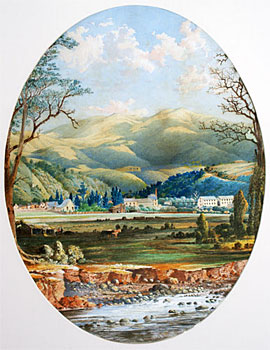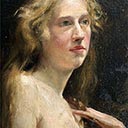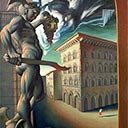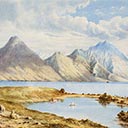Mosgiel Woollen Mill
39 x 30 cm
est. $25,000 - 35,000
Provenance: Purchased by current owner from fhe Collections of Doctor Neville Hogg
Born at Dromoland Castle County Clare, Ireland in 1821 George O'Brien was the fifth son of Admiral Robert O'Brien, a direct descendant of Murrough O'Brien, 57th King of Thomond, and of Brian Boroimhe, Monarch of Ireland. George O'Brien was a cousin of William Smith O'Brien (1803-1864) deported to Tasmania for his part in the 1848 Young Ireland uprising, and was also a cousin of James Fitzgerald, who was at one time Superintendent of the Canterbury Province in New Zealand.
Despite these distinguished connections, the family was not well-heeled. Young George O'Brien may have been trained by a brother as a civil engineer. His parents died when he was young and at an early age he was in Melbourne Australia, where views of the town dated 1839 and 1840 survive in the collection of the state library. He left soon afterwards but had returned to Melbourne by 1850 arriving from London on the Midlothian. O'Brien worked as a draughtsman in the surveyor's office and in 1853 married Jane Mashford at St James Church, Melbourne. He was active in the Victoria Fine Arts Society and by 1854 was advertising his services as an architect and surveyor. He exhibited paintings in 1856 and 1858 and nine signed and dated watercolours of St. Kilda and nearby places in Melbourne are recorded.
By December 1863 O'Brien was living at Duncan Street, Dunedin, no doubt attracted by the prosperity induced during the Otago gold rushes. He worked as a civil engineer and was employed by the Town Board supplying them with architectural perspectives of buildings designed by several Dunedin firms.
A number of O'Brien's watercolours were exhibited in the 1865 Dunedin Industrial Exhibition. He associated with W M Hodgkins, a lawyer and aspiring watercolour painter who became very influential in Dunedin's art world. O'Brien may have given Hodgkins some instruction. O'Brien's manner showed his background in measured draughtsmanship but also represented something of neo-classical painting. In the colonial context he was unusual in his use of buildings and townscape as his subject matter. In 1876 he attended a meeting of the Otago Art Society and was well-represented in that body's inaugural annual exhibition held later that year. O'Brien's paintings were ill-received by one critic, possibly Thomas Bracken, reflecting the colonial adoption of the European taste for Turneresque Romantic landscape. Nevertheless, when O'Brien's wife died in 1879, leaving him with five daughters to raise, he embarked on a career as a professional artist.
O'Brien was of a versatile and energetic disposition, travelling around southern New Zealand, but also a heavy drinker and immensely overweight. His habits were bohemian and eventually his oldest daughter, now married, removed her younger siblings while O'Brien continued lodging with a sailor and his wife in a poorer part of the city. He spent a year in Auckland in 1887, but returned to Dunedin where he died in August 1888. His landlady inherited his residual collection and he was interred in a then unmarked grave in the northern cemetery.
This significant watercolour is possibly the best example to appear on the market. It was held for many years in the collection of the late Dr Neville Hogg until sold by auction to the current owner in 1993.





